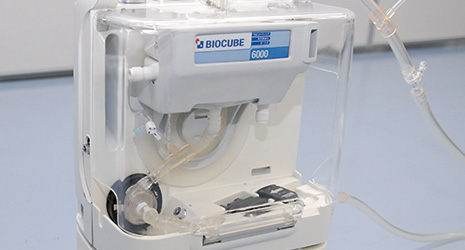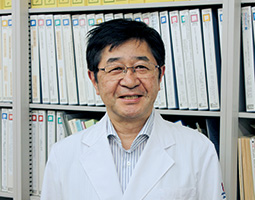Home > Highlighting JAPAN > Highlighting Japan September 2019 > Science & Technology
Highlighting JAPAN


The World’s Smallest Cardiopulmonary Support System
The National Cerebral and Cardiovascular Center has developed the world’s smallest and lightest cardiopulmonary support system. In the near future, the advance is expected to make significant contributions in the treatment of patients with severe respiratory failure.
In December 2018, the National Cerebral and Cardiovascular Center succeeded in developing the world’s smallest and lightest, next-generation cardiopulmonary support (ECMO) system. This research outcome was the work of a research group that included Eisuke Tatsumi, Director of the Center’s Department of Artificial Organs, and project researcher Nobumasa Katagiri.
ECMO is a life support system used on patients with acute heart failure and severe respiratory failure. It works by removing venous blood from the patient using a pump to send the blood along a circuit where it is oxygenated using an artificial lung. Then, once carbon dioxide has been removed, the blood is returned to the arteries of the patient (for respiratory support the blood may be returned to the veins). For patients with acute heart failure, since the pumping capacity of the heart is drastically reduced, it is unable to pump blood around the entire body, but ECMO equipment has the effect of sending oxygenated blood around the body in place of the heart. Additionally, usually patients suffering from respiratory failure have an artificial respirator attached where a tube is inserted into the airway from the nose or mouth to assist breathing, but many patients with severe conditions cannot be saved with artificial respirators due to the marked deterioration of lung function. To help these kinds of patients, ECMO sends sufficient amounts of oxygenated blood around the body through an artificial lung, allowing the patient’s lungs to rest during that period, facilitating recovery.
ECMO was originally developed so that the artificial heart-lung machines used for cardiac surgery could be used for circulatory and respiratory support outside the operating theater as well, but in recent years, its applications have also expanded to critical care and intensive care. However, as the equipment generally in use today is large and complex, it is not well suited to emergency treatment and is difficult to use outside a hospital, such as when transporting a patient with a severe condition.
Moreover, as there are risks such as the formation of clots in the insides of the equipment under extended use, requirements such as Japan’s Pharmaceutical Affairs Act limit usage of the equipment to six hours. This is why the development of ECMO systems that can be safely used for extended periods inside or outside a hospital and with simple installation have been long-awaited.
In 1986, the Center’s Department of Artificial Organs embarked upon the development of an ECMO system with excellent antithrombotic and long-term durability properties.
“At the time, achieving this kind of system was thought of as the stuff of dreams. But thanks to the culmination of various advanced technologies that have been practically implemented by the Department of Artificial Organs over the past three decades, we have managed to create a device that exhibits emergency responsiveness, portability, resistance to clotting and durability,” says Director Tatsumi.
The newly developed device is the world’s smallest and lightest (29 × 20 × 26 cm, weighting 6.6 kg), and can be carried around easily. In addition, it can be used continuously for an hour or more even where a power supply or oxygen supply is not available thanks to a built-in battery and detachable oxygen canister unit, enabling support for the transportation of patients via ambulance, for example.
What’s more, it also incorporates technologies developed by the Department of Artificial Organs in the past to prevent the formation of blood clots, preventing thrombotic and hemorrhagic complications and successfully improving safety by a considerable degree. In terms of long-term durability, in animal testing using the equipment, as a result of seven sessions during which the equipment was used for 2 to 4 weeks continuously after attachment, in all cases the equipment completed the scheduled period of use without issue. The development process for the equipment is almost complete, and the center is now taking a leading role in preparations for physician-led clinical trials. Treatment using the new equipment is scheduled to commence from the first half of 2020.
Director Tatsumi expects the practical utilization of the system to lead to dramatic improvements to quality of life (QOL) for patients.
“For patients who find it difficult to breathe on their own, we attach an artificial respirator where a tube is inserted into the airway. Under these conditions, patients are unable to speak as they are lying on a bed. But with this new ultra-compact ECMO system, patients might be able to remove artificial respirators to walk to the bathroom on their own, and converse with family members. This is expected to make a significant contribution to QOL for patients requiring respiratory or circulatory support for extended periods, such as those with lung or heart transplants.”
© 2009 Cabinet Office, Government of Japan







